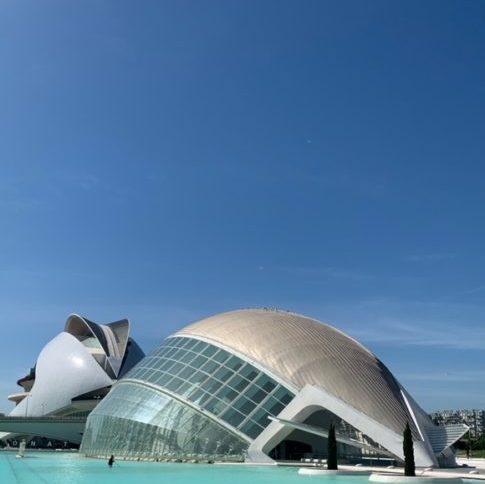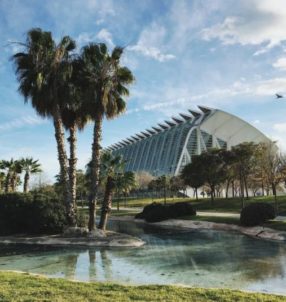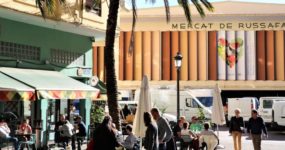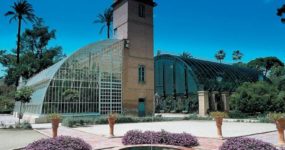Here at ‘24/7 Valencia’, we spent the week exploring ‘Ciutat De Les Arts I Les Ciències’, or ‘The City of Arts and Sciences’. It is a cultural and architectural complex, based in the South-East end of Valencia’s Turia Gardens(https://247valencia.com/el-jardin-del-turia-of-valencia-introduction). It is one of the most popular modern attractions in the city of Valencia and listed as one of the twelve Treasures of Spain.
Museu De Les Ciencies
My week began with visiting Museu De Les Ciències, or the Museum of Science. The museum spans across 3 floors, with free exhibitions open to the public on the ground floor.
As a Space lover, the 3rd floor is what struck my interest the most. With the exhibitions I was fascinated with all the knowledge and interactive experiences I was gaining. The Museu De Les Ciències has become a reference in interactive science and its main objective is to “foster curiosity and critical spirit, trying to surprise and amuse the public.”
I was luckily enough to be able to join a school trip for their live science on stage experience in the “Science Theatre”. Four guest Scientists were invited to answer any questions they may have and then the museum itself put on an interactive show, demonstrating different experiments and inviting the children on stage themselves to participate. Despite the language barrier, the show was entertaining and informative just through the visuals.
There is enough variety within museum that guests of all ages will be able to enjoy the exhibitions, from Once Upon A Time: Science For Story Lovers to The Legacy Of Science, an area dedicated to Scientists throughout history. Alongside a gift shop and indoor and outdoor cafeteria areas, there is enough here to spend a day exploring.
L’Hemisfèric
Opening in 1998, The Hemispheric was the first building within the City of Arts and Science to open its doors. The building itself is spectacular, designed by Santiago Calatrava with an ovoid roof designed to replicate an eye and an approximate surface of 13,000 M².
L’Hemisfèric houses three projection systems on a concave screen of 900 M², it is the largest room within Spain to provide this. It is an IMAX cinema, planetarium and laserium with “digital projections to live adventures through spectacular images”.
The Hemispheric opens at 10am and plays a variety of different projections throughout the day, such as Amazon Adventure and Travel Into Space. The film I chose to watch was Secrets Of The Universe, an award-winning film from 2019 that explores the journey to the largest machine and greatest scientific instrument – The Large Hadron Collider (LHC).
The Hemispheric is also known as the “eye of knowledge” and is divided in half by a set of stairs that descend into the vaulted concrete lobby. Walking down these stairs and into the building feels like walking into a piece of art or something abstract, this is amplified once you reach the project room. With colour shows and calming music playing as you take your seat, I already knew this would be an immersive experience. We were given a headset, with the option to choose your viewing language from Spanish, Valencian or English. Different projections have different language options, and this information is easily accessed when booking tickets or viewing the itinerary online.
Due to the large screen size and theatre-style seating, it is easy to get lost within the film, there is even a pre-show warning that if you begin to feel nauseous to close your eyes for a few moments as it is such an intense viewing experience.
The Secrets Of The Universe was an incredible watch, focusing on modern day scientists and discovering but covering how each small scientific breakthrough throughout history from Galileo to Darwin to Marie Curie has brought us to the present day. We learn about the origin of matter and discoveries in particle physics and explore the most exciting machines conceived by man.
I have already booked myself a ticket to view another projection at The Hemispheric, but I am secretly upset I am too old to view the live planetary session for children ages 3 to 6 on Saturdays and Sundays at 12am.
L’Oceanogràfic
To finish off an incredible week, I ventured to Europe’s largest aquarium – L’Oceanogràfic. The aquarium represents the main marine ecosystems on the planet via different avant-garde buildings, each identified by different aquatic environments; Mediterranean, Wetlands, Temperate, Tropical Seas, Oceans, Antarctic, Arctic, Islands and the Red Sea. Alongside these, there is also one of the largest dolphinariums in the world with daily Dolphin Bio-Educational Exhibitions.
I began my day taking the escalators down from the main entrance building and checking out the gift shop. I was surprised to see so many sustainable soft toys, filled using recycled plastic bottles! I made my way to the Mediterranean, large tanks filled with every species of jellyfish imaginable met me along with huge tanks and information boards. I loved how much seating was available and the calming music, I took my time to sit and watch. As I went midweek and with Coronavirus restrictions the aquarium was not overly busy, and I had no trouble being able to see each exhibition.
Next, I headed to the Wetlands and Aviary, a large 26-metre-tall sphere where two of the most characteristic coastal wetlands of the planet are represented, the American mangrove and the Mediterranean Marshland. A variety of birds, turtles and other amphibians inhabit this space, the birds were accustomed to guests and fearlessly soared and glided overhead. I stopped at one of the menu food venues for a reasonably priced fresh pastry and coffee whilst birdwatching the Flamingos and Pelicans, which inhabit the central lake.
I then braved the Shark Tunnel, an amazing span of underwater tube you can walk through whilst surrounded by varieties of sharks, stingrays and other underwater predators. The exhibitions were all in immaculate condition and it was clear the animals were well looked after.
I then took to the large igloo dome that houses the Arctic Area. At twelve metres tall, divided into two levels this represents the ecosystem in which the Beluga Whale family is found. From the upper level you can see a view of ice blocks whilst on the lower level offers a close, underwater perspective of the freezing water and Beluga Whale family. Oceanographic is the place in Europe that Beluga Whales can be found and in 2016, after 502 days of pregnancy Yulka, the 20-year-old female gave birth to Kylu.
I peeked down into the underwater restaurant Submarine Restaurant to view the space and menu, the building itself is spectacular with the roof designed by Félix Candela. The restaurant is open Monday to Sunday serving lunches and Monday to Saturday, serving Dinners. It is recommended to pre-book for weekends or peak times. As I fancied a lighter lunch, I picked up a slice of vegetable pizza from Mediterráneo Pizzeria and enjoyed the outdoor terrace.
I visited the rest of the Habitats before finally heading to the Dolphinarium. The grandstand could normally fit a capacity of over 1,500 people and overlooks the main and four auxiliary pools. The Bio-Educational Exhibition began with the Dolphin Trainers running out and waving to guests to pop music as the Bottlenose Dolphins swam into the main pool. The show took a more emotional turn as the music slowed and the screens showed the relationship between Animal and Trainer. The Dolphins are incredibly intelligent, and this is demonstrated through their behaviour in the exhibition and the screens explaining important aspects of their biology, behaviour and conservation.
Before I knew it the day was over, I left L’Oceanogràfic feeling like I had learnt so much about the different habitats and their inhabitants. It is definitely suitable for all ages and easily accessible to all.
Report by Elizabeth Williams
Eye of Knowledge, Photo Copyright: @elizabethlauren95 // 24/7 Valencia
Article copyright 24/7 Valencia
More info: https://www.cac.es/en/home.html
Related Post
Leave a comment Cancel reply
This site uses Akismet to reduce spam. Learn how your comment data is processed.

























1 Comment
Tracy Anderson
27th May 2021 at 7:05 pmThis is definitely a destination I am going to visit when I get to travel to Valencia
As someone who is very interested in recycling and sustainability I feel the aquarium is a must see
Great article thank you